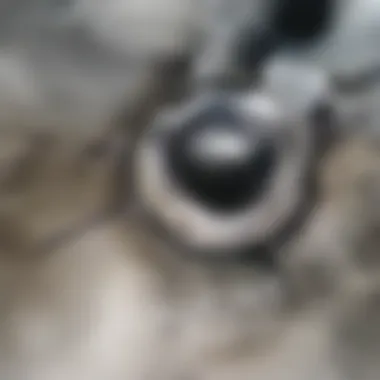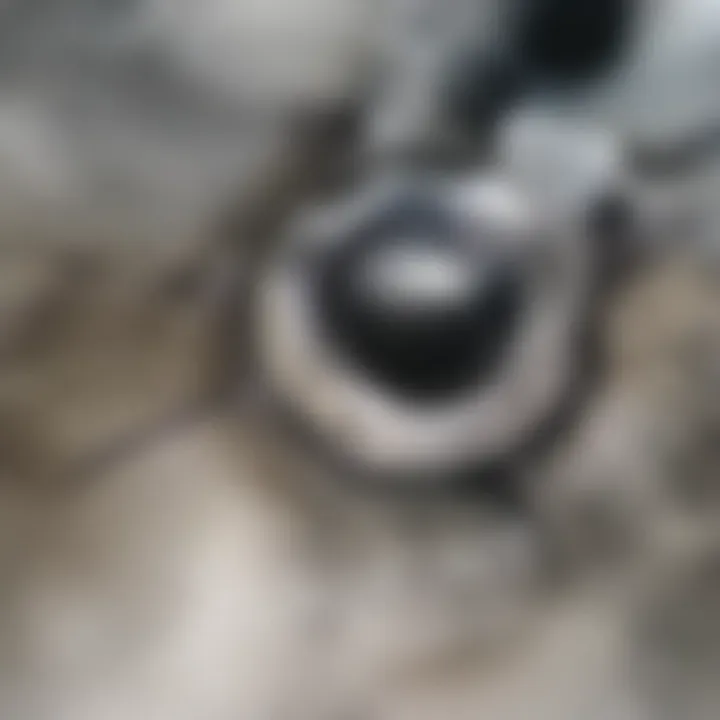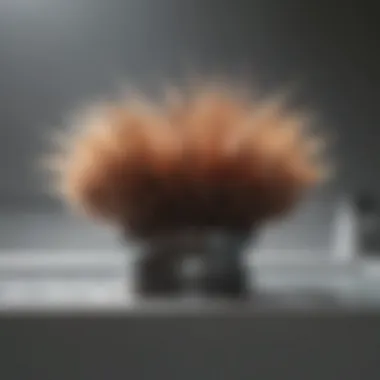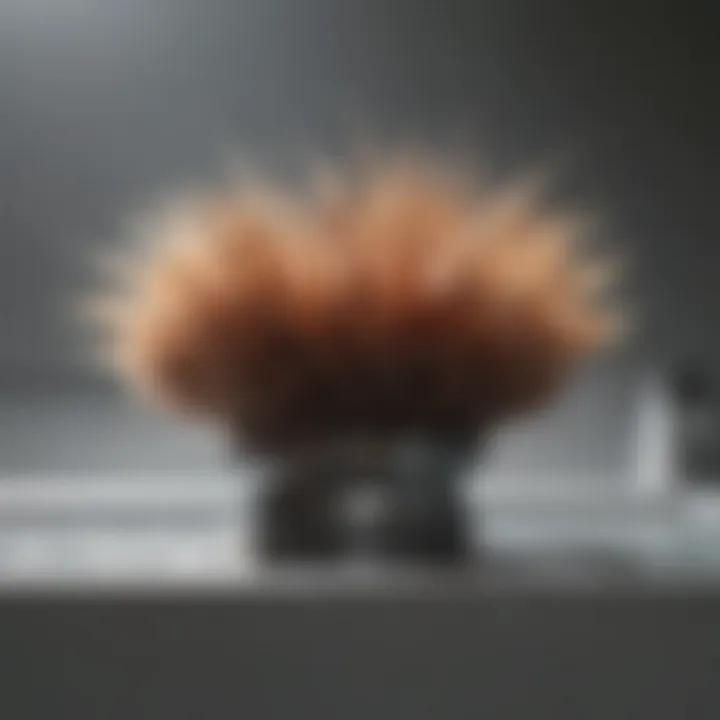Dissolving the Drain Hair Dilemma: Solutions & Strategies


Intro
Hair accumulation in drains is a common annoyance that many homeowners face. Despite the best efforts to keep bathrooms and kitchens tidy, hair can find its way into pipes, causing frustrating clogs. This problem not only leads to inconvenient plumbing issues but can also result in costly repairs if not addressed promptly. The goal of this article is to explore various methods to tackle and prevent hair clogs effectively. Here, we will dive into strategies to maintain drain health and reduce the impact of hair on plumbing systems.
Understanding Hair Clogs
Hair clogs usually occur when strands of hair mix with soap, grease, and other debris, forming a dense mass that blocks water flow. Bathrooms are particularly prone to this issue due to the high volume of hair shed during showers and grooming routines. Knowing the reasons behind hair clogs can help in devising better prevention techniques.
Common Causes
- Frequent Grooming: Regular hair brushing or styling can lead to significant hair loose end.
- Inadequate Drain Covers: Poorly fitted or absent drain covers allow hair to easily enter the plumbing system.
- Old or Compromised Pipes: Aging pipes may have rough surfaces that capture hair more easily.
Understanding these causes highlights the importance of regular maintenance and prompt action when issues arise.
Prevention Methods
To keep your drains clear of hair clogs, a few preventative steps can be quite effective.
- Use Drain Screens: Install high-quality screens over your drains to catch hair before it can enter the pipes.
- Regular Cleaning: Make it a habit to clean drains weekly. Remove any hair that has collected around drain covers.
- Educate Household Members: Ensure that everyone in your home understands proper drain maintenance to help reduce hair accumulation.
Recommended Products
Using specific products can improve the efficacy of your prevention efforts. Some top products include:
- Drano Max Gel: Designed to dissolve hair and eliminate clogs effectively.
- BioClean Drain Septic: An environmentally friendly option that helps prevent clogs while being safe for plumbing systems.
These products can be used regularly to maintain drain health and prevent potential issues.
Effective Solutions for Clogs
Should a clog occur despite your best efforts, it’s important to know how to address it.
- Plunger: A simple yet effective tool for clearing minor clogs. Use with care and follow proper technique for best results.
- Drain Snake: This can reach deeper clogs and pull out hair accumulations that a plunger may not address.
- Homemade Solutions: Consider using a mixture of baking soda and vinegar. Pour them into the drain, let it sit for a while, then flush with hot water. This can help break down hair clogs naturally.
"Taking a proactive approach to drain maintenance is crucial for avoiding costly plumbing repairs later on."
End
Managing hair in drains requires a multifaceted approach that encompasses both prevention and effective solutions. By understanding the causes of hair clogs, employing suitable products, and implementing regular maintenance practices, it is possible to maintain a healthier plumbing system. The emphasis on being proactive will save time, money, and frustrations in the long run.
Understanding Hair Accumulation in Drains
Hair accumulation in drains is often an underestimated issue that affects households and businesses alike. Understanding this problem is essential for effective maintenance and prevention strategies. Hair, being a fibrous material, can easily gather and bind with soap scum, grease, and other debris. Over time, this leads to clogs that not only cause drainage issues but can also result in costly plumbing repairs.
In this article, we will delve into multiple layers of hair accumulation in drains, including why it occurs, its consequences, and practical solutions. Recognizing the implications of hair buildup can guide individuals toward adopting better practices for their plumbing systems. Regular awareness and maintenance can save significant time and money.
The Role of Hair in Drain Clogs
Hair plays a crucial role in contributing to drain clogs. When hair is washed down the sink or shower, it does not dissolve in water. Instead, it sticks to the sides of pipes and mixes with other elements such as soap residues and dirt. This mixture forms a mat that gradually restricts water flow.
The human body sheds hair daily, with an average person losing between 50 to 100 strands. In household plumbing systems, even that small amount can accumulate over weeks and months. Showers, bathroom sinks, and even kitchen sinks experience this accumulation, leading to noticeable slow drainage and foul odors.
Common Causes of Hair Buildup
Several factors contribute to hair buildup in drains. Understanding these can help in identifying preventive measures:
- Personal Grooming Habits: Activities such as washing hair, shaving, and using hair styling products significantly increase the amount of hair entering the drainage system.
- Old Pipes: Aging plumbing may have rough or corroded surfaces, making them more susceptible to hair and debris adherence.
- Poor Maintenance: Lack of regular cleaning can allow hair to accumulate unnoticed until a clog forms. Households that do not implement regular drain maintenance suffer frequently from this issue.
- Type of Drainage System: Certain drainage setups are more prone to clogs due to design flaws or inadequate sizing for the volume of water and waste flowing through them.
Overall, understanding the role of hair in clogging drains and its common causes equips homeowners and renters alike with knowledge that aids in proactive management of their plumbing systems.
Identifying Hair-Related Drain Issues
Identifying hair-related drain issues is a crucial aspect of maintaining a healthy plumbing system. Understanding the signs and consequences associated with hair clogs can save homeowners significant time and expense later. Early detection of blockages protects the plumbing infrastructure and contributes to a smoother daily routine.
Signs of Clogged Drains
Recognizing the symptoms of a clogged drain is essential for timely intervention. Common signs include:
- Slow Draining Water: If water takes longer than usual to drain, it may indicate a buildup of hair or other debris in the pipes.
- Unpleasant Odors: Foul smells can suggest decomposing hair and other organic matter stuck in the piping.
- Gurgling Noises: Sounds coming from drains while flushing or draining water can signal air trapped behind the clog.
- Water Backflow: Backflow of water into sinks or tubs is a warning sign that a clog has formed, often requiring immediate attention.
Addressing these issues promptly can help prevent larger problems down the line.
Consequences of Ignoring Clogs
Neglecting to address hair-related clogs can lead to numerous serious consequences. Recognizing these risks is necessary:
- Pipe Damage: Prolonged clogs can exert pressure on pipes, leading to cracks or bursts, resulting in costly repairs.
- Mold Growth: Stagnant water can create an environment conducive to mold growth, threatening air quality and pose health risks.
- Increased Plumbing Costs: Ongoing issues with clogs will likely increase utility bills and maintenance costs as plumbing systems struggle to function efficiently.
"Ignoring hair clogs might seem harmless initially, but over time, they can escalate into more severe plumbing problems that are difficult and expensive to manage."
In summary, identifying hair-related drain issues involves being proactive in recognizing signs and understanding the potential ramifications of clogs. By doing so, homeowners can uphold both the effectiveness of their plumbing systems and the overall integrity of their residences.
Preventive Measures to Reduce Hair Buildup
Preventive measures are crucial in addressing the problem of hair accumulation in drains. Implementing these strategies can save homeowners from the frustration and costs associated with clogged plumbing systems. Regular upkeep not only mitigates the severity of hair buildup but also enhances the overall efficiency of drainage systems. Understanding the importance of these preventive steps can lead to a more manageable and sustainable approach to household maintenance.


Installing Drain Covers
One of the simplest yet most effective ways to prevent hair from clogging drains is through the installation of drain covers. These devices act as a barrier, catching hair and larger debris before they can enter the plumbing.
The benefits of drain covers are numerous:
- Cost-Effective Solution: Purchasing drain covers is often a small investment compared to the potential costs of plumbing repairs.
- Ease of Installation: Most drain covers can be installed without special tools or professional assistance.
- Maintenance Simplicity: Cleaning a drain cover is a straightforward task. Regular removal and washing can prevent the buildup of hair and other materials.
In addition, it is essential to choose high-quality drain covers made from durable materials that can withstand regular use and cleaning. Consider options that fit your specific drain type, as not all covers are made for all drains.
Adopting Regular Cleaning Habits
Establishing regular cleaning habits is important for keeping drains clear of hair and other clogs. A proactive cleaning routine can help in detecting problems early before they escalate into more serious issues.
Here are key habits to adopt:
- Weekly Cleaning: Make it a practice to clean your drains at least once a week. This could include running hot water down the drain or using a mixture of vinegar and baking soda to break down minor buildup.
- Hair Removal: After showering or bathing, take a moment to remove any hair that has accumulated in the drain or on the cover. This simple step can greatly reduce the risk of a clogged drain.
- Routine Inspections: Regularly check the drains in your home. Look for slow drainage or foul odors, which can signal an impending clog.
By integrating these habits into your cleaning routine, you can help maintain clear drains and take control over hair accumulation.
"The key to effective drain maintenance lies in prevention and early detection. By taking simple steps now, homeowners can avoid costly plumbing issues in the future."
Methods for Dissolving Hair in Drains
Dissolving hair in drains is essential for maintaining the health of your plumbing system. A clogged drain can lead to serious plumbing issues, resulting in significant inconveniences and costly repairs. Understanding the methods available for removing hair blocks can empower homeowners to take action before problems escalate. Here, we will examine various approaches, focusing on chemical solutions and natural remedies, each with unique advantages and considerations.
Chemical Solutions
Chemical solutions are among the quickest and most effective methods for dissolving hair clogs. These products typically contain powerful ingredients designed to break down not only hair but also soap scum and other debris. Popular options include brands such as Drano and Liquid-Plumr. These solutions can be poured directly into the drain and act relatively fast, often within minutes.
However, while these products offer immediate results, there are several safety and environmental considerations to keep in mind:
- Toxicity: Many chemical drain cleaners contain hazardous substances that can be harmful to both humans and pets if ingested or if they come into contact with skin.
- Pipe Damage: Regular use of harsh chemicals may corrode pipes over time, especially in older plumbing systems.
- Environmental Impact: The chemicals often find their way into water systems, posing risks to aquatic life and ecosystems.
To use chemical solutions safely, follow the manufacturer's instructions carefully. Make sure to wear gloves and, if necessary, goggles to protect against splashes. Moreover, ensure proper ventilation in the area where you are using these products.
Natural Remedies
For those cautious about using harsh chemicals, natural remedies present a viable alternative for clearing hair from drains. These methods utilize common household items that are less damaging to plumbing and the environment.
One effective combination is vinegar and baking soda. This approach not only works well against hair clogs but also helps deodorize drains:
- Pour a half cup of baking soda down the drain.
- Follow with a half cup of vinegar.
- Cover the drain with a plug or cloth to keep the reaction inside.
- Wait for about 30 minutes.
- Flush with hot water to clear the debris.
Another method involves using enzymatic cleaners, which contain natural enzymes to break down organic material, including hair. Unlike chemical cleaners, these products tend to be more gentle on plumbing systems and do not emit harmful fumes. They often require a longer time to work, usually overnight, but can yield excellent results when used regularly.
Natural remedies are generally safer, but they may require multiple applications to fully resolve a significant blockage. For persistent issues, it may be necessary to seek additional help or consider combining methods.
Chemical Solutions Overview
Chemical solutions play a crucial role in managing hair clogs in residential drains. They offer a range of effective options for those facing frequent issues related to hair accumulation. Understanding the types of chemical solutions available and their benefits can help homeowners make informed choices when tackling this problem.
Chemical cleaners simplify the process of maintaining drain health. They provide fast and effective results, often breaking down hair and other organic matter quickly. These products are especially valuable for busy individuals or households where regular maintenance is challenging.
It is also essential to weigh the advantages against potential risks when using chemical solutions. These products can contain harsh substances that may be harmful to both the environment and plumbing systems. Therefore, careful consideration and adherence to safety guidelines are necessary.
Common Drain Cleaners
Multiple drain cleaners are available on the market, each tailored for specific needs. Some of the most common types include:
- Liquid Drain Cleaners: These are concentrated solutions that can pour directly into the drain. They usually work quickly to dissolve hair and other materials.
- Gel Drain Cleaners: These have a thicker consistency, allowing them to adhere to the walls of pipes better than liquid forms. This quality often enhances their effectiveness at breaking down clogs.
- Foaming Drain Cleaners: These products expand within the pipes. When they foam, they can reach areas that liquid solutions may not. Their action can help lift hair and debris upwards.
Brands like Drano and Liquid-Plumr are prevalent choices for homeowners looking to clear hair clogs effectively.
Safety Considerations
While chemical drain cleaners can be effective, safety should always come first. Here are some important safety considerations:
- Read Instructions Carefully: Following the manufacturer’s guidelines is crucial. Each product has specific directions for safe and effective use.
- Protective Gear: When using chemical cleaners, always wear gloves and goggles to prevent skin and eye irritation.
- Ventilation: Ensure adequate ventilation in the area where the chemical is being used. This step minimizes inhalation of potentially harmful fumes.
- Avoid Mixing Products: Different cleaners can react negatively with each other, leading to dangerous chemical reactions. Stick to one product at a time.
- Dispose Properly: Dispose of any unused or outdated chemical cleaners responsibly. This practice minimizes environmental impact.
The right choice of chemical drains cleaner can make a significant difference in maintaining drain health while ensuring safety in the process.
Natural Remedies for Hair Clogs
Natural remedies for hair clogs present an effective alternative to harsh chemicals. They often involve household items that are safe for both the environment and your plumbing system. These remedies are important for maintaining drain health. They address hair accumulation without contributing to long-term damage or increased costs. Using natural methods can save money while keeping drains flowing smoothly. By employing these strategies, homeowners can be proactive in tackling hair-related issues.
Vinegar and Baking Soda Method
One of the most popular natural remedies is the combination of vinegar and baking soda. This method utilizes the chemical reaction between these two substances to break down hair clogs. To use this technique, first, you pour a half cup of baking soda down the drain. Follow this with a half cup of white vinegar. The mixture will start to fizz and bubble, which helps dislodge hair and other debris trapped in the pipes.
After letting it work for about 30 minutes, flush the drain with hot water. This step clears any remaining residue. This method is cost-effective, easy, and made from items commonly found in most kitchens.
Tip: Using this method regularly can help prevent future build-up in drains.
Using Enzymatic Cleaners
Enzymatic cleaners offer another natural solution for hair clogs. These cleaners contain enzymes that break down organic materials, including hair. They work by targeting specific types of waste buildup in pipes, converting them into smaller, more manageable pieces.


To use enzymatic cleaners, simply follow the product's instructions. These cleaners are typically poured down the drain and then allowed to sit for a specified period. This duration helps the enzymes work effectively. Unlike chemical cleaners, enzymatic options tend to be safer for pipes and the environment.
When using enzymatic cleaners, it's essential to remember that they may require several applications for tough clogs. However, their gradual action makes them a gentler choice for regular maintenance.
Overall, incorporating these natural remedies into your drain care routine can facilitate healthier plumbing systems. This minimizes the risk of significant clogs and contributes to more efficient drainage performance.
Manual Removal Techniques
Manual removal techniques are essential when addressing hair clogs in drains. These methods provide a direct way to tackle accumulation. Unlike chemical or natural remedies, they allow for immediate intervention. This section outlines two primary techniques: using a drain snake and employing plumbing tools. Both methods have distinct benefits, risks, and prerequisites worth considering.
Using a Drain Snake
A drain snake is a flexible tool designed to dislodge debris, particularly hair, from pipes. Its design allows it to navigate bends in plumbing systems effectively. The primary advantage of using a drain snake is its ability to remove significant clogs without the need for harsh chemicals. Here are some key points regarding drain snakes:
- Effectiveness: Drain snakes can break up stubborn hair clumps and restore flow in the pipes.
- Ease of Use: Many models are user-friendly. Whether you are a homeowner or someone with limited plumbing experience, operating a manual snake is typically straightforward.
- Cost-Effective: Drain snakes are relatively inexpensive compared to hiring a plumber for simple clogs.
However, using a drain snake requires caution. Improper technique can lead to pipe damage or personal injury. Always wear gloves, and if the clog is severe, consider seeking professional help.
Employing Plumbing Tools
Employing various plumbing tools can also assist in managing hair clogs. These tools range from plungers to specialized augers. They serve different functions but focus predominantly on clearing blockages. The benefits of using plumbing tools include:
- Variety of Tools Available: Plungers can push through minor clogs. For more severe issues, an auger or a toilet auger can reach deeper obstructions.
- Manual Control: Users have full control over the removal process. This control allows for feedback on how effectively the clog is being addressed.
- Known Techniques: Many techniques used with manual tools are documented and readily available for DIY enthusiasts.
However, understanding when to use each tool is crucial. A plunger is suitable for sinks or toilets, yet not all tools are effective for every type of clog. Care must also be taken to avoid causing damage to the plumbing system during use. Always approach manual removal methods with patience and an understanding of your plumbing's specifics.
Considering Professional Help
When dealing with hair-related drain issues, one might consider handling the situation independently using various methods discussed in this article. However, there are instances when the need for professional help becomes undeniable. Enlisting the services of a skilled plumber can bring benefits that DIY methods cannot always guarantee.
Professional plumbers have experience in identifying the underlying causes of clogs and how to effectively address them. They are trained to handle intricate plumbing systems and have access to specialized tools that provide a deeper clean. This can potentially save time and effort, ensuring that the issue is resolved correctly on the first attempt.
Seeking help from a professional can also prevent further damage to your plumbing system, leading to more costly repairs later on.
When to Call a Plumber
Certain signs can indicate the need to consult a plumber. If you find that multiple drains in your home are backing up, it may suggest a more serious blockage in the main sewer line.
Other compelling reasons to call a professional include:
- Persistent slow drainage, even after attempts of using chemical solutions or manual removal.
- Frequent clogs that require multiple attempts to resolve.
- Foul odors that emanate from the drain, indicating possible buildup causing decay.
- Water pooling around drains or sinks, suggesting a leak or blockage.
In these situations, relying on a professional's expertise is not just wise; it is often necessary to safeguard your property.
Cost Implications of Professional Services
Cost considerations are critical in deciding whether to seek professional plumbing services. On average, hiring a plumber can range between $100 to $300, depending on the complexity of the issue and the services offered. While this may seem steep, consider the potential expense of extensive damages caused by a recurring clog.
Some factors influencing the cost include:
- The severity of the problem
- Accessibility of the plumbing issue
- Types of materials needed for repair
Investing in a plumber now can potentially mitigate greater costs. In addition, regular maintenance checks with a professional can keep your plumbing issues minimal and manageable.
Overall, when navigating hair-related drain problems, assessing whether to engage professional help can lead to effective resolution and long-term drain health.
Long-term Drain Maintenance Practices
Maintaining the health of your drains is essential. Long-term drain maintenance practices can prevent future issues, saving you time, money, and hassle. Over time, hair and other debris can accumulate in your plumbing system, causing clogs and other complications. Implementing a regular maintenance routine can significantly reduce these risks.
Regular Chemical Treatments
Regular application of chemical treatments is crucial to keep your drains free from hair buildup. Many homeowners underestimate the effectiveness of these treatments. Properly chosen chemical cleaners can break down organic material, including hair.
- Types of Treatments: Common chemical cleaners include sodium hydroxide and sulfuric acid. These substances can dissolve hair and grease, but they should be used cautiously. Always read instructions and follow safety guidelines.
- Application Frequency: Depending on your household's usage, consider applying these treatments monthly or quarterly. Frequent use can enhance the efficacy of the treatments and reduce buildup over time.
Important Note: Be aware of what chemicals you choose. Some drain cleaners can damage pipes, especially older ones. Opt for those labeled as safe for all pipe types.
Routine Inspections and Cleaning
Routine inspections are an often overlooked aspect of drain maintenance. Taking a proactive approach ensures any issues are identified early. Regular reviews can detect early signs of hair accumulation and prevent larger problems.
- Inspection Methods: You can inspect your drains visually. If you notice slow drainage, it might indicate buildup. You can also use tools such as a flashlight to look into drains for visible clogs.
- Cleaning Practices: Simple home cleaning techniques like pouring boiling water down the drain can help clear minor clogs. Baking soda followed by vinegar can also help to dislodge hair and debris.
By adopting these long-term maintenance practices, you contribute to a more effective drainage system in your home. Taking time upfront can save significant costs and repairs down the road.
Environmental Considerations
Understanding the environmental aspects of drain maintenance is vital for several reasons. In this section, we focus on how certain cleaning methods impact plumbing systems and what alternative solutions can mitigate negative effects.
Impact of Chemicals on Plumbing
Many traditional drain cleaners contain harsh chemicals. Substances like sodium hydroxide and sulfuric acid are effective at dissolving hair clogs, but using them can create long-term problems. These chemicals not only degrade the plumbing over time but can also affect the overall ecosystem. When these substances eventually wash down the drain, they may contaminate local water sources.
Several environmental implications arise from using chemical drain cleaners:


- Pipe Corrosion: Chemicals can erode pipes, leading to leaks and costly repairs.
- Water Pollution: Chemical runoff can enter waterways, harming aquatic life.
- Human Health Risks: Residual chemicals may pose health hazards, affecting both users and wastewater treatment workers.
Considering these factors, it becomes clear that while chemical solutions may provide quick fixes, they contribute to larger environmental concerns.
Eco-friendly Alternatives
Many individuals are now seeking greener options to maintain drain health. Eco-friendly alternatives exist that are less harmful to plumbing and the environment. Here are some simple yet effective methods:
- Baking Soda and Vinegar: This combination creates a natural fizzing reaction that can help dislodge hair and debris without harmful residues.
- Enzymatic Cleaners: These products use natural enzymes to break down organic material, effectively targeting hair clogs while being safe for pipes and the environment.
- Regular Maintenance: Incorporating routine drain cleaning with non-toxic solutions can ultimately prevent significant hair buildup and clogging.
- Drain Covers: Installing screens or covers prevents hair from even entering the drain, reducing potential blockages before they start.
By choosing eco-friendly methods and products, home and property owners can maintain their drains more sustainably. This not only helps in conserving plumbing health but also fosters a responsible approach to environmental stewardship. Furthermore, opting for these alternatives reinforces the importance of balancing effectiveness in drain maintenance with the well-being of our ecosystems.
Understanding Plumbing Systems
Understanding plumbing systems is critical in addressing hair-related drainage problems effectively. Plumbing systems are designed to facilitate the flow and removal of wastewater from a building, ensuring proper sanitation and hygiene. A thorough knowledge of these systems can reveal how hair clogs develop and their impact on overall plumbing functionality.
Hair, often combined with soap scum and other debris, can cause significant issues when it accumulates in pipes. The build-up may lead to partial or complete blockages, resulting in slow drainage or overflowing fixtures. Different types of pipes react uniquely to hair accumulation. For example, PVC pipes are less prone to retention compared to older cast iron pipes, which have more surface area for hair and debris to cling to.
The geometry and materials of plumbing systems not only influence how hair interacts with pipes but also how easily blockages can be removed. Thus, understanding these details can assist in choosing effective preventative and treatment measures for maintaining drains.
How Hair Affects Different Types of Pipes
The way hair interacts with various types of plumbing pipes can significantly affect drainage efficiency. In modern plumbing, pipes such as PVC and copper are commonly used due to their resistance to corrosion and smooth surfaces, which typically minimizes debris accumulation.
On the other hand, older systems that utilize cast iron and clay pipes can be problematic. These materials are rougher and can create niches where hair can accumulate. Over time, as hair combines with other organic materials, it forms tougher clogs.
- PVC Pipes: Less prone to clogs due to smooth surfaces.
- Copper Pipes: Generally resistant to corrosion but can develop scale and mineral deposits.
- Cast Iron Pipes: Encourage accumulation due to their rough surfaces.
- Clay Pipes: Prone to tree root intrusions, amplifying blockages.
It is essential for homeowners to know their plumbing materials to better understand and anticipate hair-related issues.
Hydraulics of Drainage Systems
Understanding the hydraulics of drainage systems can further clarify how hair clogs arise. Hydraulic principles govern the flow of water within pipes, dictating how waste travels through a plumbing system. If there are clogs, the flow is impeded, creating back pressure which can lead to additional problems.
Factors affecting hydraulic performance include:
- Pipe Diameter: Wider pipes can handle greater volumes and resist clogs better than narrower ones.
- Slope of Pipes: Properly sloped pipes facilitate gravity flow, minimizing the potential for hair accumulation.
- Flow Velocity: Higher velocities can help in pushing debris through; however, slower flows increase the likelihood of blockages.
Understanding these components allows one to identify potential trouble spots in a plumbing system and apply necessary interventions before issues escalate. Regular maintenance and clear knowledge of how hair influences plumbing systems can lead to healthier drains and less frequent and costly repairs.
Cost-Effectiveness of Drain Management
The cost-effectiveness of drain management plays a crucial role in maintaining the functionality of plumbing systems in homes. Addressing hair accumulation in drains can significantly reduce both immediate and long-term expenses associated with plumbing repairs. When homeowners invest time and resources into proper management strategies, it can help prevent costly emergencies and ensure a more efficient plumbing system overall.
One of the primary benefits of a cost-effective drain management approach is the reduction of emergency repairs. Clogs caused by accumulated hair can block water flow, leading to overflow or leaks. Prompt action can often mitigate the need for emergency plumbing services, which are usually more expensive. Implementing preventive measures can result in substantial savings over time.
Additionally, using preventive tools, such as drain covers or hair traps, incurs a low up-front cost yet offers significant value by preventing larger clogs. This deliberate investment in simple tools translates into savings. The accumulation of hair not only leads to clogs but can also contribute to the degradation of plumbing fixtures. Thus, managing hair accumulation can extend the life of plumbing systems, ultimately saving homeowners from the high costs of replacements.
Furthermore, understanding drainage systems' dynamics can inform better maintenance practices.
"An informed approach to drain maintenance reduces the likelihood of unexpected plumbing issues and fosters a more sustainable home environment."
Investing in Preventive Tools
Investing in preventive tools for drain management is a pragmatic step that homeowners can take to minimize hair buildup. Tools such as drain screens and hair catchers offer a simple yet effective way to intercept hair before it enters the drainage system.
- Drain Screens: These devices can be fitted over sink and shower drains. They act as barriers, capturing hair and debris while allowing water to flow freely.
- Hair Catchers: Available in various forms, hair catchers can be placed in bathtubs or sinks. They provide an additional line of defense against hair clogs.
The cost of these tools is often negligible compared to the potential expenses associated with clogged drains. Beyond simply preventing clogs, these tools can also reduce the frequency of need for chemical drain cleaners or professional services. Therefore, the long-term financial impacts of investing in such tools are overwhelmingly positive.
Comparing DIY and Professional Solutions
When faced with the challenge of hair clogs, homeowners often debate between DIY methods and hiring professionals. Both approaches have their merits and drawbacks.
DIY Solutions can be appealing
- They often require little cost and utilize commonly available household items. Methods such as using vinegar and baking soda or a drain snake can be effective without needing professional intervention.
- However, these methods may not suit all situations, particularly severe blockages deeper in the plumbing system.
Professional Solutions
- Hiring a plumber guarantees that the blockage is addressed effectively. They have the tools and expertise to handle complex drain issues.
- Nevertheless, the cost of professional services can be significant, especially for frequent clogs. Depending on the area's plumbing issues, it may lead to financial strain over time.
Finale: Ensuring Healthy Drains
Maintaining the integrity of drains is crucial in any household. The accumulation of hair can lead to significant issues if not addressed promptly. This section outlines the importance of consistent practices and engaging professionals when persistent problems arise.
Maintaining Consistent Practices
To prevent hair clogs, one must adopt proactive habits. Regularly cleaning drains can help mitigate buildup. Here are some effective practices:
- Routine Cleaning: Flush drains with hot water once a week. This can help dissolve any potential buildup before it becomes a serious clog.
- Use Drain Covers: Install mesh screens or strainers to catch hair and debris before they enter the drain.
- Periodic Inspections: Check for early signs of slow drainage, which might indicate a clog starting to form.
Implementing these practices can significantly improve the health of your drains. They not only prolong the life of the plumbing but also reduce the need for commercial cleaning products and costly repairs.
Engaging with Experts for Persistent Issues
Despite efforts, some issues may persist and require professional intervention. Knowing when to call an expert is essential. Signs that you may need to consult a plumber include:
- Repeated Clogs: If you consistently face similar drain issues, it may indicate a more serious underlying problem.
- Strange Odors: Foul smells can suggest trapped food or waste.
- Backup in Multiple Drains: This can indicate a blockage in your main sewer line, necessitating professional assessment.
Practical considerations accompany these signs. Hiring professionals can provide peace of mind and ensure that proper techniques are employed. While this may involve an upfront cost, addressing the problem effectively often saves money in the long run by avoiding extensive damage.
Ultimately, ensuring healthy drains is an investment in both the functionality and longevity of your plumbing system. By maintaining consistent practices and knowing when to seek expert help, homeowners can effectively manage the hair accumulation dilemma.















